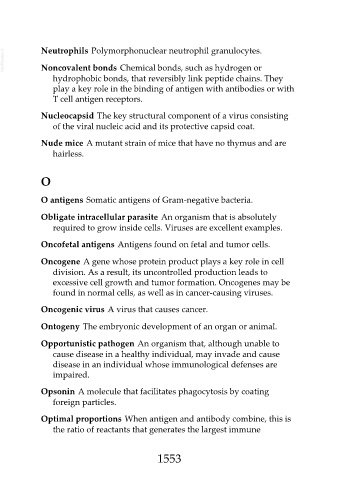Page 1553 - Veterinary Immunology, 10th Edition
P. 1553
VetBooks.ir Neutrophils Polymorphonuclear neutrophil granulocytes.
Noncovalent bonds Chemical bonds, such as hydrogen or
hydrophobic bonds, that reversibly link peptide chains. They
play a key role in the binding of antigen with antibodies or with
T cell antigen receptors.
Nucleocapsid The key structural component of a virus consisting
of the viral nucleic acid and its protective capsid coat.
Nude mice A mutant strain of mice that have no thymus and are
hairless.
O
O antigens Somatic antigens of Gram-negative bacteria.
Obligate intracellular parasite An organism that is absolutely
required to grow inside cells. Viruses are excellent examples.
Oncofetal antigens Antigens found on fetal and tumor cells.
Oncogene A gene whose protein product plays a key role in cell
division. As a result, its uncontrolled production leads to
excessive cell growth and tumor formation. Oncogenes may be
found in normal cells, as well as in cancer-causing viruses.
Oncogenic virus A virus that causes cancer.
Ontogeny The embryonic development of an organ or animal.
Opportunistic pathogen An organism that, although unable to
cause disease in a healthy individual, may invade and cause
disease in an individual whose immunological defenses are
impaired.
Opsonin A molecule that facilitates phagocytosis by coating
foreign particles.
Optimal proportions When antigen and antibody combine, this is
the ratio of reactants that generates the largest immune
1553

